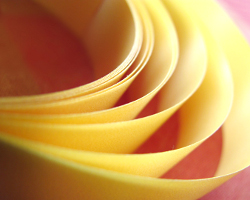 Nicky has emailed to ask how she can recycle:
Nicky has emailed to ask how she can recycle:
Almost 100 kilometres of 2″ wide yellow florists ribbon. Unravelled and of varying lengths – very long to short pieces. Currently in 5 large industrial bags.
Wow, that’s a fair bit of ribbon! My first thought would be to offer it to a local scrap store – they collect unwanted materials from businesses and the like, and redistribute them to local schools, community groups and crafters for upcycling & repurposing. Many will collect suitable materials from businesses too, so it’s worth a shot.
Another option would be to offer it on Freecycle/Freegle – it’s unlikely that anyone would want all five bags but a few people might be willing to take a bag each, for their own craft/redistribution purposes.
As for actually recycling it, most florists’ ribbon is made of polypropylene (plastic number 5), which can be recycled so a plastics recycling company may be interested in it. (I don’t know how much 100km of ribbon weighs – most recycling companies like a minimum of around a tonne) I don’t have any particular recommendations for Nicky though – anyone know any plastic recycling companies around London?
Any other suggestions for ways to reuse it, recycle it or pass it on? Preferably ideas suitable for reusing/recycling 100km of the stuff rather than individual craft suggestions.
(Photo by michaelaw)
Categories: business, items
Posted by louisa
on 22 July 2011
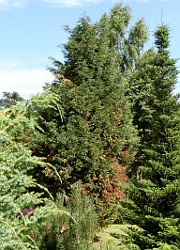 We’ve had an email from Jennifer (sorry it’s taken a few weeks to feature it, Jennifer!):
We’ve had an email from Jennifer (sorry it’s taken a few weeks to feature it, Jennifer!):
We hacked down a couple of huge nasty Leylandii conifer trees from our garden this weekend and don’t know what to do with the wood and branches. It’s far too much for our own compost bin, fear for the state of our car if we tried to take them to the council compost collection because they’re dropping resin and I’ve read that you shouldn’t burn them. My husband thinks the only option might be hiring a skip for landfill but I’d still prefer a green option!
Ahh, Leyland Cypress. Depending on your point of view, it’s either the useful sound/pollution blocking instant-hedge or the scourge of urban gardens with its own Asbo law.
As we have a woodburning stove and a father-in-law who skip-dives for all sorts of wood, we’ve read quite a bit about burning leylandii – some people say as long as it is sufficiently dry (seasoned), it’s fine to burn and is actually a good start-of-fire accelerator. But it is full of sticky resin which can clog up chimneys with creosote and cause chimney fires – the pro-burning-it people say as long as it’s seasoned and completely dry, this isn’t a problem but it takes a good couple of years to reach that state. (Outdoor fires, such as bonfires, won’t have a build-up problem but if you burn it fresh/green, it will give off clouds of smoke and spit furiously.)
A quick Google tells me that some people use sections of cut-down Leylandii trees in aviaries to provide secluded roosting space for small birds. Other people shred them up and use them as woodchippings for paths – they will compost down eventually but will probably take a few years. If you don’t fancy doing either of those things, perhaps someone on your local Freecycle/Freegle may be interested in doing it…?
Any other suggestions or ideas?
Categories: garden, items
Posted by louisa
on 18 July 2011
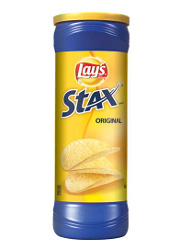 Tammy Gary has asked:
Tammy Gary has asked:
Would love ideas to reuse the Stax potato chip cans.
We don’t have Stax over here in the UK but my friend Google tells me they’re like Pringles, but packed in a plastic tube instead of waxed cardboard.
Some of the Pringles ideas will still apply: they’re great for storing knitting needles and paintbrushes, can be used as storage for homemade biscuits, and is useful as a small poster tube – for either storing documents without creasing or sending through the post.
As these bad buys are plastic (rather than card) so water-resistant, they will lend themselves to other reuses too – I’d imagine they could easily be turned into a bird feeder (cut a couple of feeding windows about a third/half of the way up, add a perch at the bottom then fill with seed), could be used for storing dried goods in the kitchen or as storage for small kids’ toys (eg lego or jigsaw pieces) or crayons.
Any other suggestions?
Categories: food, items, packaging
Posted by louisa
on 15 July 2011
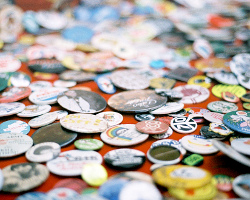 (Ooops, sorry for the absence – I was busy then ill because I’d been busy and also ill because I ate some tasted-fine-but-actually-bad out of date sausages. Yes.)
(Ooops, sorry for the absence – I was busy then ill because I’d been busy and also ill because I ate some tasted-fine-but-actually-bad out of date sausages. Yes.)
Right then, Nicole has been in touch asking about “pinback buttons”:
I have thousands of pinback buttons from a failed work campaign. Would love to make them over into something pretty and/or useful. Any suggestions?
I think “pinback buttons” are what we in Britain usually just call “badges” – which we have covered before. There are some great reuses on there (I love fabric covered badges) but I’m not sure if that’s an appropriate suggestion for Nicole – unless she wants to make thousands of them. The decorative pinboard pins idea might be better – since you’d use a good number on a pinboard at a time – unless the campaign failed so badly that you don’t want to be reminded of it ;)
Any more ideas for using up a lot of pinback buttons/badges?
(Photo by Ellen Munro)
Categories: household, items, office
Posted by louisa
on 13 July 2011
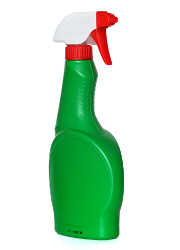 We’ve had lots of suggestions over the years on how to reuse spray bottles from commercial cleaning products and the like but Nancy has just emailed a related question:
We’ve had lots of suggestions over the years on how to reuse spray bottles from commercial cleaning products and the like but Nancy has just emailed a related question:
First I want to comment that this is a fantastic website! Everyone in the world should be accessing it.
My question is this:
I’m recycling plastic spray bottles to put pure, herbal cleaning products in. Is there a way to make sure these bottles are clean and free of chemical residue before I reuse them? A way to sanitize them first?
If I was going to use it for another cleaning product, I probably wouldn’t go overboard with cleaning it, just a washout with water or something, (unless the original product was very bleachy or something that would react with my new product) — I personally wouldn’t mind the chemical residue dregs for that first refill. If I was reusing the spray bottle for something else (eg, as a water spray for plants) though, then I’d probably wash it out more thoroughly (a few rinses of hot water) – but still probably not to a level that I’d class as “sanitizing” it so I don’t know what is needed to do that.
(My boyfriend) John uses baby bottle sterilising tablets when he’s cleaning plastic bottles for homebrew – and often has sterilising fluid leftover once his bottles are clean — it is, admittedly, a very weak bleach solution but is apparently stabilised so safer than normal bleach and doesn’t need rinsing off feeding utensils/bottles before they’re used. It seems like overkill to whip up a new batch of the fluid to clean out a cleaning products bottle but if you have it leftover from another use anyway…
Any other suggestions? How much effort do you make to clean out cleaning product bottles before reusing them?
Categories: household, items, packaging
Posted by louisa
on 7 July 2011
 Nicky has emailed to ask how she can recycle:
Nicky has emailed to ask how she can recycle:


 We’ve had an email from Jennifer (sorry it’s taken a few weeks to feature it, Jennifer!):
We’ve had an email from Jennifer (sorry it’s taken a few weeks to feature it, Jennifer!): Tammy Gary has asked:
Tammy Gary has asked: (Ooops, sorry for the absence – I was busy then ill because I’d been busy and also ill because I ate some tasted-fine-but-actually-bad out of date sausages. Yes.)
(Ooops, sorry for the absence – I was busy then ill because I’d been busy and also ill because I ate some tasted-fine-but-actually-bad out of date sausages. Yes.) We’ve had
We’ve had 














